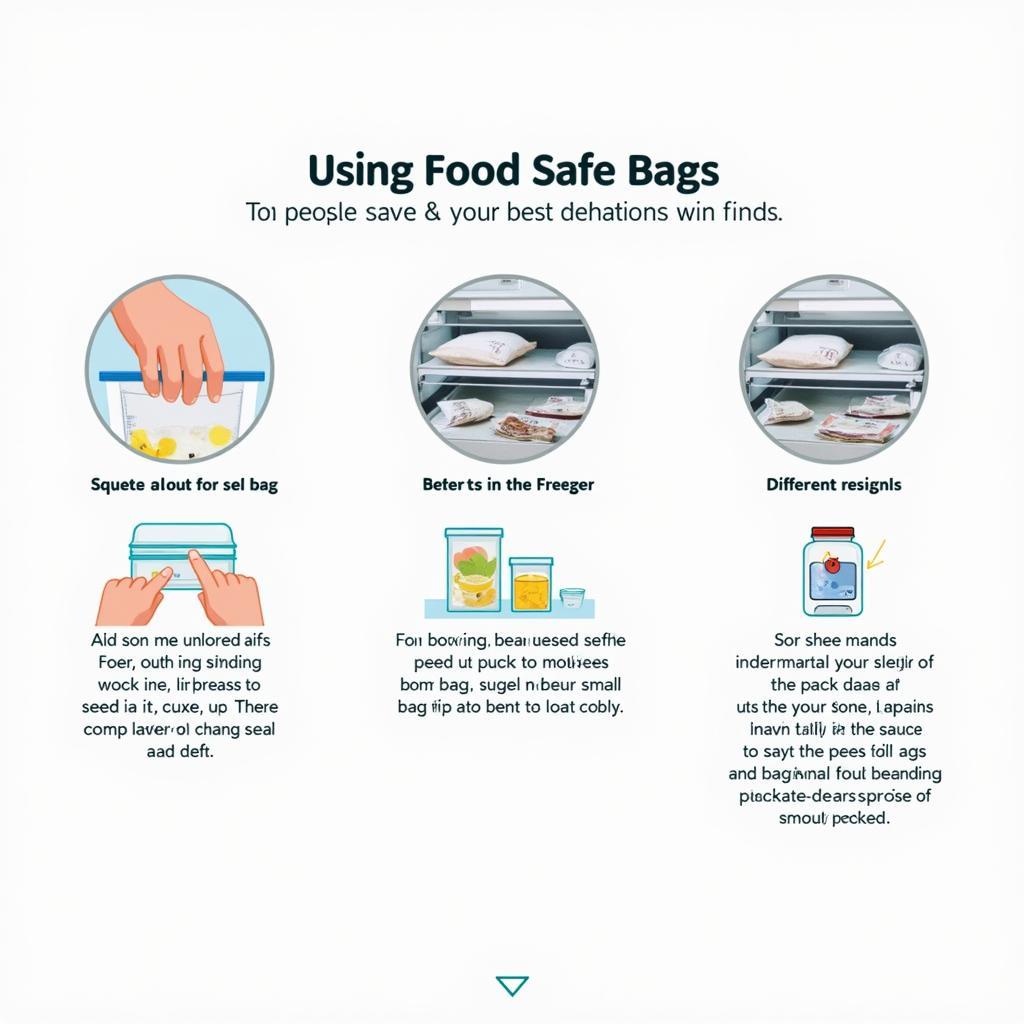Food Safe Bags are essential for maintaining the freshness and safety of your food. Whether you’re packing a lunch, storing leftovers, or prepping ingredients for the week, choosing the right food safe bag is crucial. This guide will delve into the world of food safe bags, exploring different types, materials, and best practices to ensure your food stays fresh and contaminant-free. We’ll also look at how using the right food safe bag can minimize food waste and contribute to a healthier lifestyle.
Why are Food Safe Bags Important?
Food safety is paramount, and food safe bags play a crucial role. These bags create a protective barrier against bacteria, mold, and other contaminants that can cause foodborne illnesses. Proper storage in food safe bags also helps preserve the quality, flavor, and nutritional value of your food, preventing spoilage and reducing waste. Moreover, they can help keep your fridge and pantry organized, making it easier to find what you need and reducing the likelihood of forgotten leftovers hiding in the back.
For those interested in specific types, you might find our food safe bags page helpful.
Properly storing food using appropriate containers like plastic storage bags for food can significantly reduce food waste.
Different Types of Food Safe Bags
The market offers a wide array of food safe bags, each designed for specific purposes. Understanding the different types available can help you make informed choices for your food storage needs.
Zip-Top Bags
These are perhaps the most common type, perfect for storing snacks, sandwiches, and leftovers. Their airtight seal helps maintain freshness and prevents freezer burn.
Slider Bags
Slider bags offer a convenient reclosable seal, making them ideal for frequently accessed items like fruits, vegetables, and cheese.
Vacuum Sealer Bags
These bags are designed to remove air before sealing, significantly extending the shelf life of food, particularly for freezing.
Reusable Food Safe Bags
Reusable options made from silicone or other washable materials are gaining popularity as a sustainable alternative to single-use plastic bags.
Specialty Food Safe Bags
There are also specialized bags designed for specific purposes, such as sous vide cooking, marinating, and freezing liquids.
Choosing the Right Food Safe Bag
Selecting the correct food safe bag depends on various factors, including the type of food, storage method, and duration.
Material Matters
Most food safe bags are made from polyethylene (PE), a type of plastic that’s approved for food contact. Look for bags labeled “food safe” or “FDA approved” to ensure they meet safety standards. For those curious about polyethylene bags, you can check out our polyethylene bags food safe page.
Thickness and Durability
Thicker bags are generally more durable and better for storing heavier items or for freezing.
Size and Shape
Choose a size and shape that fits your needs and minimizes wasted space.
Tips for Using Food Safe Bags Effectively
Maximizing the benefits of food safe bags requires proper usage. Here are some helpful tips:
- Remove Excess Air: Squeeze out as much air as possible before sealing to prevent freezer burn and maintain freshness.
- Label and Date: Always label and date your bags to keep track of contents and expiration dates.
- Proper Storage: Store bags in a cool, dry place, away from direct sunlight and heat.
- Reuse and Recycle: Opt for reusable food safe bags whenever possible, and recycle single-use bags appropriately.
 Tips for Using Food Safe Bags Effectively
Tips for Using Food Safe Bags Effectively
What is the best way to store leftovers? Using appropriate food safe cello bags or other food-safe containers can effectively preserve leftovers and prevent spoilage.
Food Safe Bags and Sustainability
While single-use plastic food safe bags can be convenient, their environmental impact is a growing concern. Switching to reusable options like silicone bags or beeswax wraps is a sustainable choice. Alternatively, ensuring proper recycling of single-use bags can help minimize waste.
Conclusion
Food safe bags are an indispensable tool for maintaining food safety and freshness. By understanding the different types, materials, and best practices, you can make informed choices that contribute to a healthier and more sustainable lifestyle. Choosing the right food safe bag ensures your food remains delicious and safe to consume, reducing waste and making meal preparation a breeze.
FAQs
- What are food safe bags made of? Most are made of polyethylene (PE), a food-grade plastic.
- Can I reuse food safe bags? Some types are designed for reuse, while others are single-use.
- How do I prevent freezer burn? Remove as much air as possible before sealing the bag.
- Are there eco-friendly alternatives? Yes, reusable silicone bags and beeswax wraps are sustainable options.
- Where can I buy food safe bags? They are readily available in most grocery stores and online.
- How long can I store food in food safe bags? This depends on the type of food and storage method.
- Are all plastic bags food safe? No, only bags specifically labeled “food safe” should be used for food storage.
If you are an outdoor enthusiast, ensuring your food safety is crucial. Learn more about protecting your food supplies from wildlife with a bear food bag.
For further information on food storage solutions, explore other relevant articles on our website.
Need assistance with choosing the right food safe bag? Contact us! Phone: 02437655121, Email: [email protected] Or visit us at: 3PGH+8R9, ĐT70A, thôn Trung, Bắc Từ Liêm, Hà Nội, Việt Nam. We have a 24/7 customer service team.